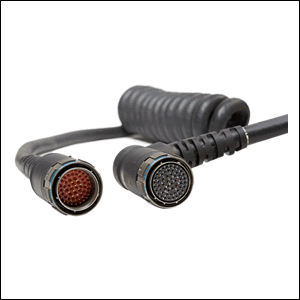The Process of Cable Assembly Molding
For clients who truly understand the process of cable assembly molding, which can include cost advantages over a fully mechanical approach, the selection of a vendor is the key to procuring a robust and reliable product.
 While a molded cable assembly can offer significant advantages over a similar product with a mechanical construction, the art of insert molding remains somewhat of a mystery to cable assembly consumers. While attracted by the potential for a more aesthetically pleasing product that can be sealed from the environment and rendered tamper-proof, the complexity of the insert molding manufacturing process is often overlooked.
While a molded cable assembly can offer significant advantages over a similar product with a mechanical construction, the art of insert molding remains somewhat of a mystery to cable assembly consumers. While attracted by the potential for a more aesthetically pleasing product that can be sealed from the environment and rendered tamper-proof, the complexity of the insert molding manufacturing process is often overlooked.
Many cable assembly engineers who are consumers – but not producers – of molded assemblies are familiar to some degree with conventional molding. In this environment, the goal is the maximization of process speed, which translates directly to bottom-line financial performance. Manufacturing lot sizes are often characterized by long runs, where the same part is produced continuously over a considerable amount of time. The molding machines are usually horizontal in construction, use a closed-cavity approach with auto-ejection of the finished parts, and operate at much higher injection pressures and speeds than an insert-molding process. Additionally, the often-uniform nature of the parts relative to wall thickness, balanced runner systems, and sufficient draft on the molded parts being produced serves to support consistent quality in the face of maximum manufacturing speed. The ability to optimize tool cooling, standardize mounting, and implement automated processes is also a major differentiator between the conventional horizontal molding and vertical insert molding approaches. The result, all things equal, is a much higher production rate for finished parts in a conventional molding process.
What then are the challenges of the insert molding process used to manufacture cable assemblies, and, more importantly, how do manufacturers overcome them?
At a high level, there are four major areas of consideration when discussing the intricacies of insert molding. These include the operator, tooling, equipment, and the process itself. Let’s examine each of these in more detail.
The Operator
As with any non-automated process, it is the operator who is often the most important component of the success or failure of a manufacturing lot. This is especially true in cable assembly molding. In addition to knowing the basics of machine operation, the operator must properly monitor and control several variables if he or she is to produce parts that meet the established design and quality guidelines. In light of some of the equipment and component variability discussed earlier, some of these operator-focused considerations include:
• Residence time – This is the amount of time the molten plastic can remain in the barrel of the molding machine before it produces aesthetic issues on the finished part.
• Part loading – With components loaded into the molding machine by hand, improper location during the process may result in a non-conforming finished part.
• Cable management – Keeping the cable out of “pinch points” where it can become damaged is critical. This can become an area of concern for molded assemblies that include a great deal of bulk cable as well as composite products where several molds have already been applied to the product before an additional molding operation is initiated.
• Process adjustments – Due to potential differences between similar components in the areas of dimensions, heat withstand, and pressure withstand (compression), as well as the ability to properly shut off in key areas of the part, the operator’s degree of experience and ability to recognize the early signs of potential process variation are critical to ensuring the efficiency and quality of the molding operation.
• Shot consistency – The failure to introduce enough molding material during the molding process (a short shot) can result in exposed components which may or may not be able to be re-worked depending on the amount of material introduced during the process and the adhesion of that material to the specific components involved. Conversely, the introduction of too much material during the process (over-packing) can result in compromised physical parameters, material visibility in the face of the connector, and damaged cable jackets with holes in the jacketing sheath. These conditions can be avoided with an attentive and experienced operator.
It should be noted that even the most well-trained, experienced operator will bring a degree of variability to the equation not present in the automated, high-volume environment of conventional molding. Training, process feedback, and proper engineering and supervisory support are basic mechanisms critical to minimizing the variability between operators and ensuring production is maximized while cost is driven to the lowest possible levels.
In addition, operator performance can be maximized through additional strategies that include:
• Cycle time maintenance: It is important to establish a workflow where the molding machine is not left waiting for the operator to initiate a new cycle due to load-time inefficiency. This can be accomplished by proper staging of materials which includes consideration of whether the operator is right or left handed; Kaizen events focused on reducing or eliminating any unnecessary motion or material handling that detracts from an optimized machine-loading time; and additional molding support for jobs that require significant materials preparation or in-depth recording of critical dimensions.
• Operator evaluations: A formal assessment of the operator in the areas of manual dexterity, eye-hand coordination, and organizational skills ensures the individual is properly matched to the requirements of the job.
• Training in machine mechanics: While knowing how to operate the molding machine is important, knowing how the molding machine operates is equally critical. By understanding the machine technically, the operator is better positioned to identify and defeat potential problems before they can affect the manufacturing efficiency.
Tooling
Because connectors and cable can vary from manufacturer to manufacturer, or even within the scope of a specification if purchased from a single manufacturer, the mold tooling must be designed with the ability to properly direct and contain (shut off) the molding material even in the face of component variability. The tooling designer is faced with additional variables introduced by the presence of the insert – or connector in most cases – and cable. Those variables include inconsistent wall thicknesses, cable and insert compression, and the effects of thermal exposure, to name only a few. Proper gate size and location will serve to defeat a multitude of cosmetic and mechanical issues such as knit lines, sink marks, and jetting. In addition to the aesthetic and mechanical considerations, the design engineer cannot lose sight of operator ergonomics, an equally important design consideration.
In a manufacturing environment where product appearance is critical and cannot be sacrificed for process speed and throughput, the tool designer must also determine if a single- or multi-cavity approach is best suited to the product particulars, to include both design and expected manufacturing lot size. Due to the lower durometers of some of the molding plastics often associated with cable assembly molding and the longer set-up times for those materials, as well as the available real estate on the smaller mold sizes associated with cable assembly manufacturing, often there is no opportunity to add knock-out pins or automate the ejection of the part. An experienced tool designer can, however, include design elements that allow for efficient manual ejection of the finished part.
Equipment
As with any manufacturing process, the proper equipment is a critical part of successful operations. Preventative maintenance, as well as daily housekeeping, are both necessary to ensure minimal downtime for the molding machines. Matching the requirements of the part to the capabilities of the machine is an important part of the equipment discussion that is often overlooked. Molding machine manufacturers recommend that 20% to 80% of a machine’s barrel – which is directly related to its ability to process molding compound – is used when the machine is in operation. Choosing a machine that is too small for the application will significantly increase the potential for non-conforming parts, as the machine cannot introduce the required amount of compound during each cycle, which creates a short-shot condition. If the machine chosen is too large, the molding material spends too much time in the barrel before introduction, thus increasing the possibility of aesthetic issues with the finished part due to heat damage to the molding compound as a result of thermal residence issues. Improper machine selection can result in inefficiency and manufacturing inconsistencies that will impede throughput, disrupt schedules, and increase cost.
Process
Unlike the long-run, high-speed, low-variability parameters of conventional molding, insert molding presents an environment fraught with process challenges. The smaller lot sizes imply multiple set-ups. It is not uncommon for an operator to break down and set up several times over a given day of production. With each set-up comes downtime, as well as the potential for set-up scrap as each new manufacturing run obtains the proper conditions required by the specific product.
While a D-sub connector, for example, may meet certain universal specifications, frequently there are undocumented product characteristics that may vary from manufacturer to manufacturer and even between manufacturing lots from the same vendor. Because of the heat and internal pressure the molding process generates, marginal components may not be able to withstand the conditions the process creates. This can result in the potential for not only scrap and downtime but a complete cessation of production as well. Well-designed tooling, well-controlled sourcing, and experienced operators are the best defense against the effects of component variability.
The characteristics of conventional molding, namely a high-speed process with large lot sizes that produces an ideally designed part in an automated environment, are not part of the injection-molding process associated with molded cable assemblies. In this world, the process is bound by variability within the components, non-uniform wall thicknesses required as part of the product specification, tooling considerations that often work against an optimum design, and a severely limited ability to automate.
For clients who understand the benefits of a molded product, which, depending on the connector systems involved, can include cost advantages over a fully mechanical approach, the selection of a vendor is the key to procuring a robust and reliable product. Ideally, the manufacturer is an experienced vendor, has an established record of superior engineering and design support, has demonstrated success with molded cable assemblies across multiple markets, and can offer maximum control over the various manufacturing phases of the final product to include the wire and cable and mold tooling fabrication.
Authors Mike Levesque, marketing communications manager; Shawn Young, mechanical design manager; and Brock Richard, process engineer; all work for C&M Corporation.







